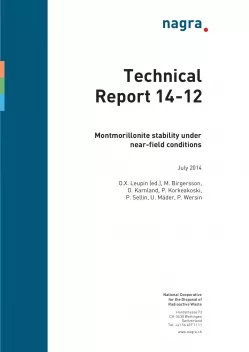
Technical Report NTB 14-12
Montmorillonite stability under near-field conditions
Clay-based engineered barriers comprising bentonite and bentonite/sand mixtures are the favoured option in geological repositories for high-level waste due to their inherently low hydraulic conductivity at full saturation. This ensures that diffusion of solutes such as radionuclides will be the dominating mechanism for transport through the engineered barriers. Another advantageous property of bentonite is the development of swelling pressure in contact with water under the constant volume conditions of repository excavations, ensuring the closure of unintentional gaps or openings. The predictability of the long-term behaviour of bentonite (up to a million years) is thus key to the safety analysis.
The thermal pulse from the radioactive decay of the radionuclides in the high-level waste and spent fuel will lead to temperatures significantly higher than in the undisturbed host rock for hundreds of years, which may influence the thermodynamic stability and kinetics of alteration reactions of montmorillonite, the smectite that is the main constituent of the bentonite. The aim of this report is to review the present understanding of potential alteration of bentonite by focusing on experimental and modeling results under the thermal conditions of a repository.
Many studies show that the transformation of smectite-to-illite is induced by increasing temperature and potassium activity. The conversion process is complex and still not completely understood. Nonetheless, it displays very slow kinetics over a wide range of environmental conditions for the temperatures of interest.
The various models for illitisation of smectites suggest negligible transformation in a repository due to the relatively short period of elevated temperatures and slow mass transport. However, because of uncertainties and a number of conservatisms in the application of such models, the results of such calculations should be considered as bounding and indicative and not as quantitative predictions.
In addition to the review of published studies, three sets of experiments were performed to study potential changes to the safety-relevant properties of bentonite during the high temperature period of a repository and the results may be summarized as follows:
- Smectite-to-illite hydrothermal experiments with MX-80 bentonite at 270 °C and variable potassium activity conditions did not evidence any illitisation in reacted samples for either raw bentonite or Na-exchanged bentonite reacted in "granite-type" solution regardless of the presence of added K-feldspar or the more abundant accessory mineral content in the raw bentonite.
- Experiments on thermal stability of montmorillonite at 90 – 150 °C showed that montmorillonite dissolved and released silica, which resulted in a layer charge increase located in the tetrahedral sheets. The montmorillonite was consequently altered in the direction towards beidellite – a swelling smectite mineral.
- Experiments on the effect of steam on the swelling capacity of bentonite showed that water vapor at temperatures up to 200 °C and water unsaturated conditions do not cause a significant reduction of the water uptake capacity of montmorillonite.
Based on the review and additional studies performed, it can be concluded that the swelling pressure and the hydraulic conductivity, which are important safety function indicators for clay barriers, are not expected to be significantly affected by the thermal transient that will occur in the discussed repositories.
